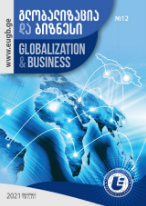ANTI-CRISIS POLICY OF THE LEADING CENTRAL BANKS AT THE PRESENT STAGE
DOI:
https://doi.org/10.35945/gb.2021.12.019საკვანძო სიტყვები:
Negative Interest Rate, Pandemic, Viral-Economic Crisis, Quantitative Easing, Currency Warანოტაცია
According to a review of "Central Banks: Monthly Balance Sheets", prepared by the consulting company Yardeni Research, Inc., the assets of the four leading central banks in the world - the US Federal Reserve (FED), the European Central Bank (ECB), the Bank of Japan and the People's Bank of China (PBOC), increased by 4.8 times over the specified period. Consequently, the liabilities of the big four central banks increased by 4.8 times. As it is known, the bulk of the Central Bank's liabilities is money issued by central banks (in the form of cash and deposits, on which commercial banks place their funds). Therefore, the money supply issued by four banks in a quarter of a century has also increased by 4.8 times.
The FED was especially distinguished by the fact that it began to sharply increase the issue of money in the midst of the financial crisis of 2008-2009. This was done under the flag of "quantitative easing" (QE). There were three "quantitative easing" programs, the last one ended in 2014. However, when the US declared a "pandemic" and began to impose quarantine restrictions, the Fed's printing press was again launched at full capacity. Now the Fed buys $ 120 billion a month in the securities market ($ 80 billion in US Treasury securities and another $ 40 billion in mortgage securities). Accordingly, the dollar supply is increasing by the same amount every month.
The Bank of Japan is in second place in terms of the growth rate of assets (and money supply). It began to build up assets and money supply earlier than other leading central banks, from the end of the 20th century to the beginning of the 21st century.
At the end of February 2021, the picture has changed radically. We see a rapid rise in the value of the indicator at the Bank of Japan, at the turn of 2018-2019. It crossed the 100% bar. Now its assets are equal to 127.4% of GDP. The indicators of the relative level of assets of the Fed and the ECB have grown very much. But the Central Bank of China has reduced the relative value of its assets by about a third. This is both the result of curbing the activity of the Chinese Central Bank and the fact that China has experienced high rates of GDP growth.
As for the other three leading central banks, their policy of increasing money supply will continue. The head of the US Federal Reserve, Jerome Powell, makes it clear that the US Central Bank, at least until the end of the year, will continue to buy securities in the same volumes (that is, $ 120 billion a month).
ECB President Christine Lagarde said in March that the bank would accelerate asset purchases in the coming months under the Pandemic Emergency Purchase Program (PEPP). The volume of this program is 1.85 trillion EUR. In addition, the main ECB repurchase program continues to operate.
Other central banks that are not included in the survey by Yardeni Research, Inc. are also pursuing an asset buildup course. Among them are the Bank of England and the Swiss National Bank.
Leading central banks of the world, to justify the runaway money emission, refer to the "pandemic". The more money supply is created, the more likely it is that this currency will have a lower rate in relation to the competitor's currency. And the undervalued exchange rate of the national currency is a means of strengthening the international competitiveness of national businesses. However, such competition can lead to the collapse of the currencies of rival central banks.
Downloads
ჩამოტვირთვები
გამოქვეყნებული
გამოცემა
სექცია
ლიცენზია
საავტორო უფლებები (c) 2021 Globalization and Business

ეს ნამუშევარი ლიცენზირებულია Creative Commons Attribution-NonCommercial-ShareAlike 4.0 საერთაშორისო ლიცენზიით .









